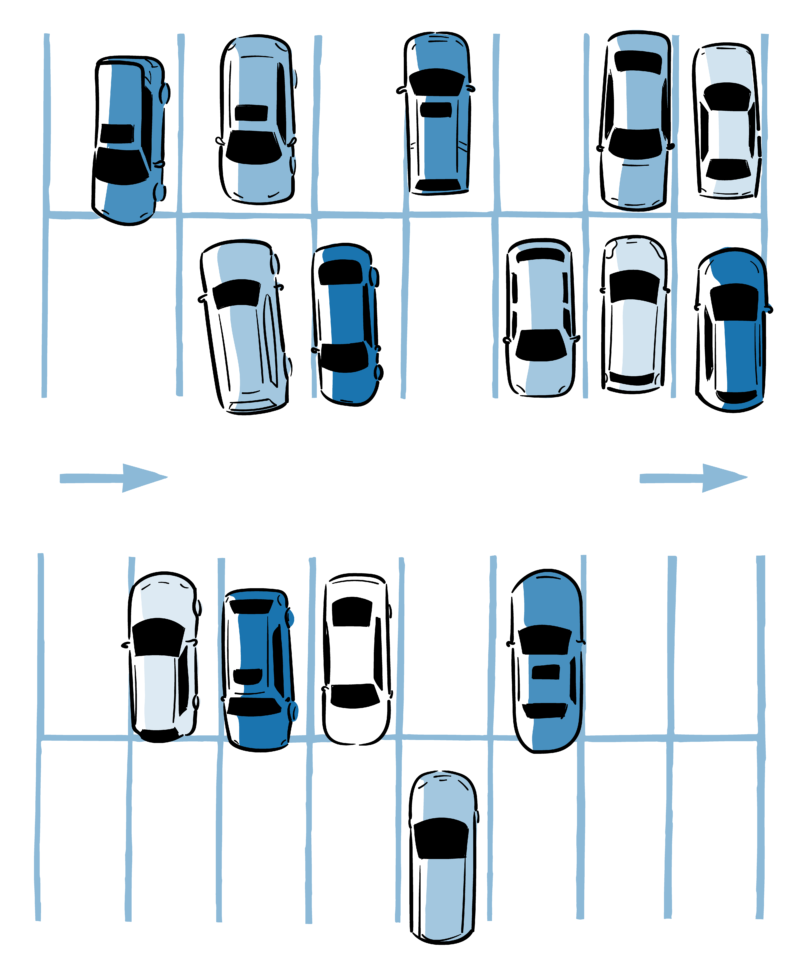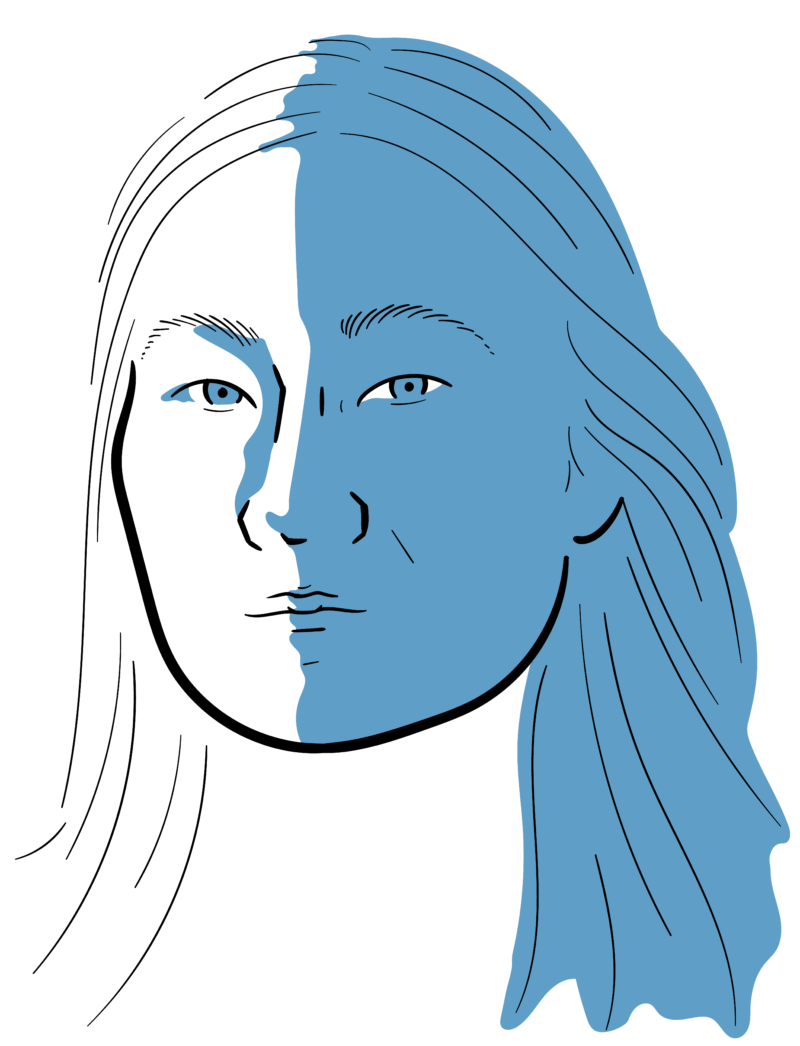FEATURES:
- Taco trucks
- Sycamores
- Supportive birds
- Freakish weeds
During the early weeks of the pandemic, I found myself pacing in parking lots. After teaching my classes some afternoons, I would just wander out in a kind of daze. I live on a street that borders Wooster Square, a small municipal park in New Haven, Connecticut, that people use to walk their dogs or jog loops around. This would have been a convenient place to pace, but in those days I wanted to avoid people at all costs, so I wandered farther, to where there were fewer people. It was like osmosis happening. Density sought emptiness; something yearned for nothing. Eventually I found my way to a huge IKEA parking lot.
The parking lot for the international housewares store is wedged between a messy tangle of several freeway exchanges (I-95, I-91, the notorious Oak Street Connector), the Metro-North rail yard, a post office, a sprawling office complex, and a stretch of garbage-strewn urban coastline touching Long Island Sound. On foggy days the air smells like brine and seaweed; on dry days, like bright metallic fumes and burned rubber; on humid days, there’s a chemical vapor, oddly sweet, which is perhaps off-gassing from the oil storage tanks across the harbor. Usually there are taco trucks parked on Long Wharf Drive, but when things shut down, they evaporated, too, along with the construction guys and long-haul truckers who had stopped there for lunch.
For me, extended time in parking lots has always signified an emergency, precise moments of narrative dissolution: one version of the good life has come apart irretrievably, and you must, humbly, construct another. Outside hospitals and motels, breakups and breakdowns. I paced because pacing feels like the good, primal thing to do when a body is penned in. It’s what lions and tigers do in their zoo enclosures. Back and forth, up and around, prowl, prowl, repeat. I organized my movements by row: up and down the parking rows toward the now-dim signs for exchanges, returns, exit, enter. The circularity of the movements, plus the weird, abstract commands, felt cosmic. I was in an undetermined space of pure matter, performing a ritual of eternal reincarnation, living many lives.
The functions of things were all floating above. I wanted to affix them but I couldn’t. Questions unspooled. What was “IKEA” if not a place to buy disposable furniture; what were “citizens” if not the purchasers or returners of these products; what was “parking lot” if not a place to temporarily store one’s car as one entered yet another temple of modern life? We were unmoored from purpose. What did it mean to be a body in space, a body that didn’t buy or sell, or go to the grocery store, or see friends, or go to school, or travel from A to B, or perform routine life as we had always imagined? This body was made of nothing if not limitations.
One day, while pacing, I noticed a few acrobatic brown birds swooping into my path and scampering alongside me. With what looked like concerned, pitying expressions, they seemed to pause and peer back at me once in a while, as though waiting for me to catch up, before rushing ahead. I had the feeling they were cheering me on. Come on! You can do it! Like in a marathon. They had black-and-white stripes on their chests, as if they were wearing high-contrast bibs. What were those birds? Oh, killdeer! The internet said they were a kind of plover, and they loved fields, airports, and yes, parking lots next to water. They weren’t here for me; they were enacting their migration and living the way they had always lived. But I’d never noticed them before.
Spring went on, and greens, pinks, whites, and yellows started popping up everywhere. There were trees planted on the margins of the lot. Swollen, reddish-chartreuse nipples—buds—appeared on the branches. Later, I learned the trees were sycamores. Their bark was white and mottled, like skewbald horses. What were those sounds above me? A soaring shadow; a cinematic, nature-show-worthy shriek. Red-tailed hawk? I saw a lot of seagulls and I became curious about identifying them too. Herring gull. Ring-billed gull. Without any human food to scavenge from the taco trucks, the gulls reverted to their gull ways and began hunting. They picked up shellfish—clams, mussels, oysters—and dropped them from great heights. They experimented with the cracking power of many different surfaces. The concrete promenade next to the Canal Dock Boathouse worked best. Soon this area was strewn with a shattered mosaic of sparkling shells.
Each day, as each new word entered my vocabulary, the world seemed to refill. What had previously been a non-place, without identity or history or relation, was slowly transforming into a place. It was getting harder to pace, because there was so much to look at. Pacing was too fast a speed for these investigations. Every other step: Wait, look down. What are those miniature hyacinth things poking out of the cracks? They look like upside-down bunches of grapes. My sister had pointed them out to me during one of our walks. Grape hyacinth. Apt name.
Summer arrived, and because the municipal crews weren’t mowing, the weeds were allowed to flourish. The weeds, overnight, burst upward with the freakish speed of an unregulated condo development. The median strip between the road and the sidewalk became a vibrant weed city, densely green. From one seething afternoon to the next, the bees, wasps, and flies arrived in droves, weaving in and out of the wildflowers. Clover, aster, dandelion. The leaves of the tall mugwort in particular were like love motels for breeding lady beetles. Each leaf was a cool room, shading them in privacy.
I thought about the mugwort on the nights I couldn’t sleep, of which there were many. Mugwort: a plant long connected with magic and healing, an herb to put under your pillow to grant vision dreams. “She helps you to find the truth of a cycle,” one blog helpfully explained. The mugwort was gendered female. “We are never still. If we are not changing, we are dead.” I stayed up late reading. Demonstrations were continuing all over the country, and we seemed to be on the precipice. I crushed some leaves in my palm and placed them in a tiny jar, not wanting to dirty my pillow. Put my head down next to the jar. Closed my eyes. You enter a trash-blown wasteland, seeing nothing but the white lines zebra-ing up into view. There are limits and borders, structures and instructions. But when you open your eyes, you will see, if only for a fleeting minute, that in the process of shedding old functions, new functions arrive. New exigencies, new forms of life.






